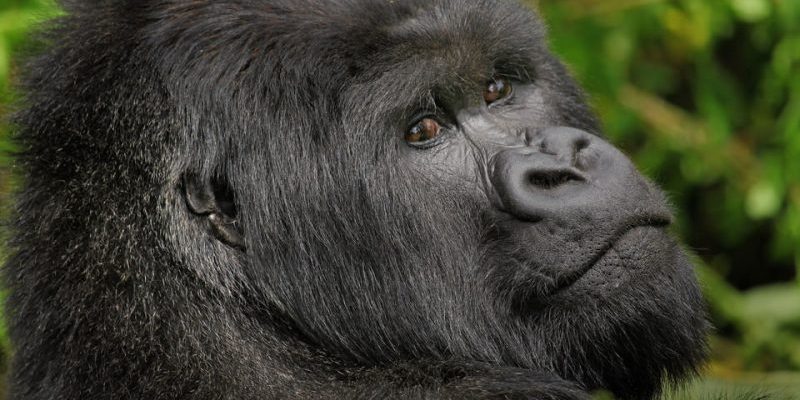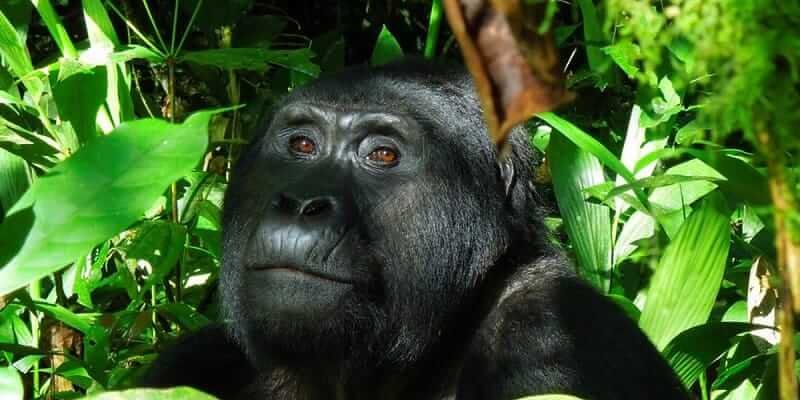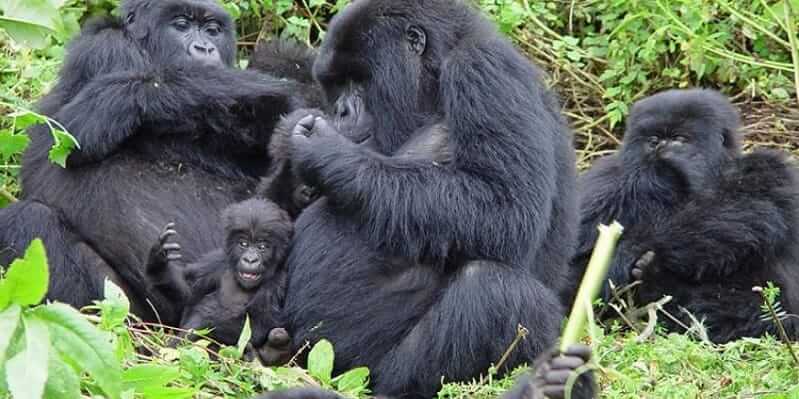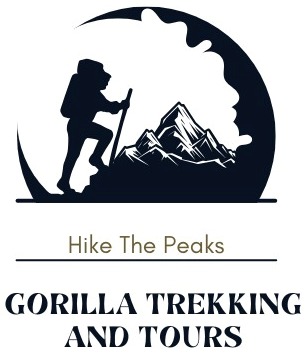
Rwanda Gorilla trekking Tours, Great Experience with the Apes
Gorilla Trekking in Rwanda takes place in the Virunga Mountains that straddle the borders of Rwanda, Uganda and the Democratic Republic of Congo. This area is home to about 400 mountain gorillas, more than half of the world’s entire population with the nigger half living in the tropical forests of Bwindi in Uganda). In the Volcanoes National Park, there are 10 habituated gorilla groups set aside for gorilla trekking tours.
The encounter with a mountain gorilla is such a magical adventure. Facing directly before the large silverback gorilla, you will gaze into its eyes and he’ll look back with a thoughtful, intelligent eye, acquainting to the presence of a human. Surely, tiredness and thoughts of a long hour hike will fade away the moment you meet with your allocated gorilla group. This is truly a magical wildlife experience like no other.
When to go gorilla trekking in Rwanda
Rwanda Gorilla trekking tours are done all year round although some travelers prefer to trek during the dry months of December – February, and June to Mid September. Wetter months of the year make the trek difficult as the hiking becomes more strenuous through the muddy trails due to heavy rains. These months are always from April – May and in November. For more details, read our full article about when to visit Rwanda for gorilla trekking.
How Much is a Gorilla Permit?
For any visitor to access entry to the park for gorilla trekking, a permit is very essential and a MUST have. At RDB offices in Kinigi, Rwanda gorilla tracking permits are sold at US$ 1,500.00 per person per gorilla trek. This permit allows you to visit a particular gorilla family with other fellow trekkers for the day. A maximum of 8 persons can visit a specific group of gorillas daily.
However, RDB also has discounted gorilla permits for travellers who are visiting for gorilla trekking but willing to spend a minimum of three nights in either Nyungwe Forest National Park or Akagera National Park during the months of November to May. These special gorilla permits reward you with up to 30% discount of the gorilla permit price hence reducing the costs to US$ 1,050 per person.
Obtaining Rwanda Gorilla Trekking Permits
Obtaining a permit in Rwanda can really be hectic especially when you make an inquiry at short notice. To avoid all this, booking should be made several months in advance. We recommend at least 3 -6 ahead, to enable us to plan for you a successful gorilla trekking safari. A total of 80 gorilla trekking permits are sold out daily at RDB offices.
What fitness level is required for gorilla trekking?
There is no fitness level pre-required to track the gorillas. However, disclosing your physical fitness will help you to be allocated a gorilla group that fits in your ability to hike. Some gorilla groups require you to walk at a slow pace with scheduled breaks if needed while other groups take long hikes along difficult trails. Depending on which group you track, and the time of year you go (gorillas tend to move down the mountains in the rains), you might find yourself walking on some pretty steep slopes for several hours. It’s best to prepare for the most active option, however, and if nothing else, a few hilly walks before you leave would be beneficial to enhance your physical fitness.
What to expect on a Rwanda gorilla trekking tour

Gorilla Trekking is such an unforgettable experience in the Volcanoes National Park. On your day as you set out to track the gorilla, you will be up by 6:00 am to have an energy-giving breakfast. Depending on where you book your accommodation for the tour, the driver will pick you from there to brief you about the necessities and highlights of the gorilla trekking experience. You will then transfer to the park headquarters for a gorilla trekking lesson (briefing) by the park guides and officials. These guides speak excellent English and French to help you get acquainted with the rules and regulations of the gorilla adventure. You will also be allocated to a specific gorilla family to track for the day. A maximum total of 8 people are allocated to each gorilla family.
You will start your gorilla trek as the driver-guides transfer you to the starting point of the allocated gorilla group to begin the hike. Throughout the search for the gorilla, you will be led by an assigned park guide who will clear up the thick bushes to create paths for you. The guide stays in constant radio communication with guides of other groups of trackers to easily located the gorilla family. The altitude in the tropical forests is over 2,500m, which means the hike sometimes could end up to be tiring and steepy in some parts. Normally, the trek takes between 1 hour to 6 hours to find the gorilla family allocated. This is dependent on the previous habitat and current movements of these primates. Don’t be surprised if you feel a bit breathless at this altitude – this is perfectly normal.
Finally, you will meet face to face with a large silverback male gorilla weighing hugely up to 200kg, or more than 3 times the average weight of a human being. This awesome encounter will make you forget the apprehension and tiredness of the hike. Often the gorillas will be spread around a small area of dense vegetation. They’ll continue with their feeding and interactions, nonchalant about their visitors, though watching you with interest. Occasionally one, often a playful youngster, will approach you with curiosity – sometimes coming so close that you’ll have to move away.
Mountain gorillas share 98% of our DNA and as such are very susceptible to catching human infections, particularly respiratory ones, but they don’t have our immune system to deal with them – a common cold could eventually prove life-threatening.
Rwanda Gorilla Trekking Rules and Regulations
Various rules for gorilla trekking are therefore in place to help protect these precious primates.
Only one group of tourists can visit the mountain gorillas each day and once you’ve found them, you’ll have just one precious hour in their company. If you have a cold, flu or other contagious infection, you shouldn’t go gorilla trekking.
- You need to keep a distance of 7m from the gorillas, although of course the gorillas themselves are unaware of this and will often get very close, in which case you should try to move away.
- When with the gorillas, try as much as you can not to make sudden movements and to keep your voices low so that the group remains relaxed.
- Although these mountain gorillas are now used to seeing people, do bear in mind that they are still wild animals and can sometimes react unexpectedly, so always heed your guide’s and trackers’ instructions.
- You won’t be allowed to eat or drink when you’re with the gorillas.
What to wear for Gorilla Trekking tours?
- Sturdy hiking boots are very handy and recommended for gorilla treks since the paths in the forests can be slippery, muddy and steep especially when it rains.
- You may also prefer to wear thick gardening gloves to protect your hands from the thorny plants and nettles you may encounter en-route.
- Past travellers also advise wearing long trousers with tucked-in cotton stockings.
- A waterproof jacket (or a poncho) is also essential to wear
- As well as energy-giving snacks and some water since it’s a long trek. You might also find a walking stick or pole helpful.
Do I Need to hire a Porter to Gorilla Trekking?
Yes, porters will assist to carry your backpacks and offer a hand during tricky parts of the hike. These are available at the trailheads as you start the hike and can be hired at a small fee. Even if you don’t really need them, hiring a porter is a helpful way to contribute directly to the local economy and chatting to them en route can enhance your experience both of local life and of your gorilla trek.
What about photography on a gorilla tour?
For photographers, taking your own pictures of mountain gorillas on a gorilla tour is one of the most magical photo sessions you’ll ever experience. Do bear in mind that however much light can be poor while in the rainforest FLASHLIGHT photography is PROHIBITED. Be sure to carry your camera bags and extra batteries to enjoy the endless photographic moments.
 Habituated gorilla groups in Volcanoes National Park, Rwanda
Habituated gorilla groups in Volcanoes National Park, Rwanda
The various groups and their locations will obviously change from time to time: mountain gorillas often climb higher in the dry season and descend during the rains, they might move on due to pressure from wild gorillas and individuals will often join other groups. When tracking gorillas, it’s possible to request to visit a specific group once you are at the park headquarters, but this can never be guaranteed. These are some of the groups currently habituated for gorilla safaris in Volcanoes National Park:
- The Sabyinyo Group has about 12 individuals, including two silverback gorillas, and is usually found relatively close to the edge of the forest (about 20–40-minutes’ walk), between Sabyinyo and Gahinga.
- Agashya Group, also known by its former name Group Thirteen, usually lives close to the Sabyinyo Group but can range very far and high. It has about 25 gorillas with 2 silverbacks.
- Usually living between the Karisoke and Visoke (sometimes called Bisoke) peaks are the Amahoro Group, with about 17 individuals, and the Umubano Group, which currently has 11 members. Both are usually further away from the headquarters than the Sabyinyo and Agasha groups, but easier to reach than the Susa Group.
- Originally studied by Dian Fossey, the Susa Group was the largest, with about 40 individuals, including 3 silverbacks. After a split (creating Igisha Group) in 2009, Susa now has 28 members. In the summer months, in particular, it can be a tough trek to reach this group high up on Mount Karisimbi, but it’s well worth the effort because of their number and because, uniquely, it has two sets of twins, which is very rare..
- The Karisimbi Group, which split from the Susa group a few years ago, also lives in the Mt. Karisimbi area of Volcanoes National Park and is also suited to visits from more serious hikers. Both of these groups can potentially involve a full day’s trek. This group also underwent a split in 2012, and now has 11 individuals.
- The Hirwa Group has around 11 members including one silverback and another pair of twins. Together with the two pairs of twins in the Susa group, these are the only known surviving twins of mountain gorillas in the world. They’re also usually found on the slopes of Sabyinyo, and tend to be one of the easier groups to trek to.
- The Kwitonda Group has 18 members and was habituated in the DRC. They crossed the border into Rwanda in 2005, and were carefully tracked and are now also being visited on a regular basis, although they are known to range far.
- The Bwenge Group, named after their silverback, has 11 members and can be a tough trek – they’ve had a lot of in-fighting and have lost a few family members, and they move around a lot, and faster.
- The Ugende Group do the same, so it’s often a harder trek. The name means “on the move” – its 11 individuals shift regularly.
- Isimbi Group were formed after the Karisimbi group split in 2012, and includes Poppy, the oldest living female (though she went missing at the end of August 2018, so her future looks a little uncertain). They have 14 members.
